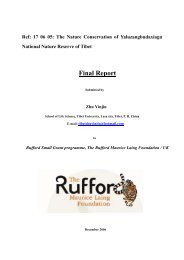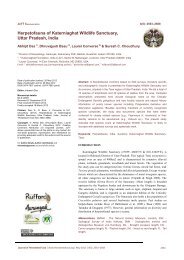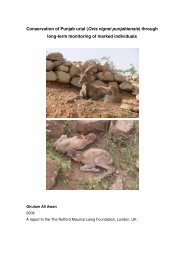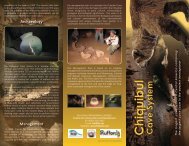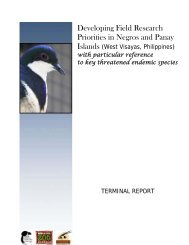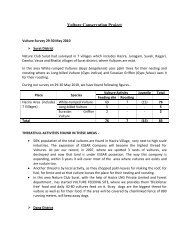Showcasing Urban Herpetofauna: A Conservational Effort through ...
Showcasing Urban Herpetofauna: A Conservational Effort through ...
Showcasing Urban Herpetofauna: A Conservational Effort through ...
You also want an ePaper? Increase the reach of your titles
YUMPU automatically turns print PDFs into web optimized ePapers that Google loves.
Important threats faced by the herps of Guwahati:<br />
Filling up and pollution of water bodies resulting in a lack of breeding<br />
ground, mainly for amphibians.<br />
Cutting down of remaining green patches and mining activities.<br />
Construction activities such as building of roads mainly the national<br />
highways which causes fragmentation of forests.<br />
Malicious killing mainly because of ignorance and superstition.<br />
Human consumption mainly of turtles is decimating turtle population.<br />
Other reasons include tarring of roads, accidental road kills, and gillnet<br />
fishing.<br />
Fertilisers and pesticides cause major threats to amphibians.<br />
In the urban environment, another problem that herps, more specifically<br />
amphibians face is the lack of breeding grounds as most of the land is<br />
concretized with no terrestrial water bodies. Also the temporary potholes<br />
within the city acts as death traps for the tadpoles as these holes dry up very<br />
rapidly.<br />
Due to ecological imbalance, the prey and predator ratio is getting out of proportion.<br />
Thus, many snakes venture into human habitation areas for easy procurement of<br />
food. This human snake encounter has three potential outcomes. In most cases it<br />
results in the death of the snake, or if the animal is lucky enough, it is rescued. The<br />
rescue process has its own short comings as most of the rescued snakes are<br />
released in the same spot leading to artificial population rise of that species in that<br />
particular area, making the snake again move back to human habitation areas,<br />
starting a cycle of release and recapture. The third consequence and the rarest one<br />
are human casualties because of snake bite.<br />
Material and Methods<br />
The study was conducted from September 2011 to July 2012. The field survey was<br />
carried out during both day and night, and four man hours was invested per<br />
survey. The survey was carried out in the morning mostly from 06:00h till noon and<br />
in the evening mostly from 17:00 to 20:00h. Few late night surveys extending up to<br />
sunrise were also conducted to find nocturnal species. Visual Encounter Survey<br />
(Crump and Scott, 1994) employing randomized walk (Lambert, 1984) was<br />
9



